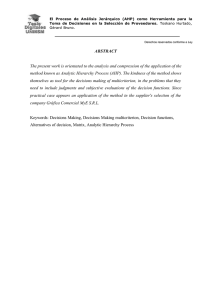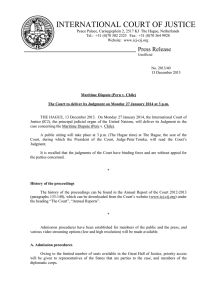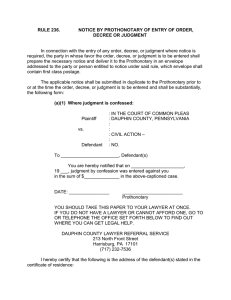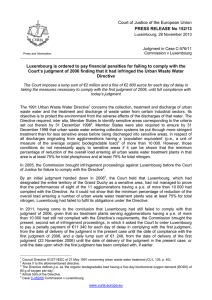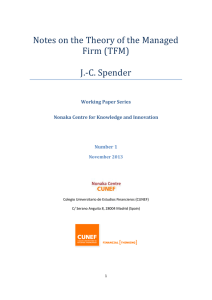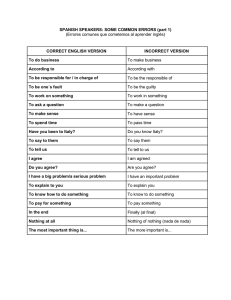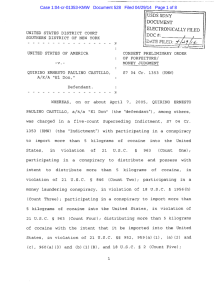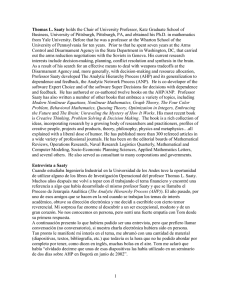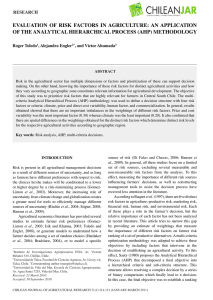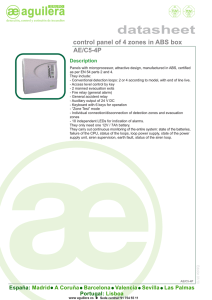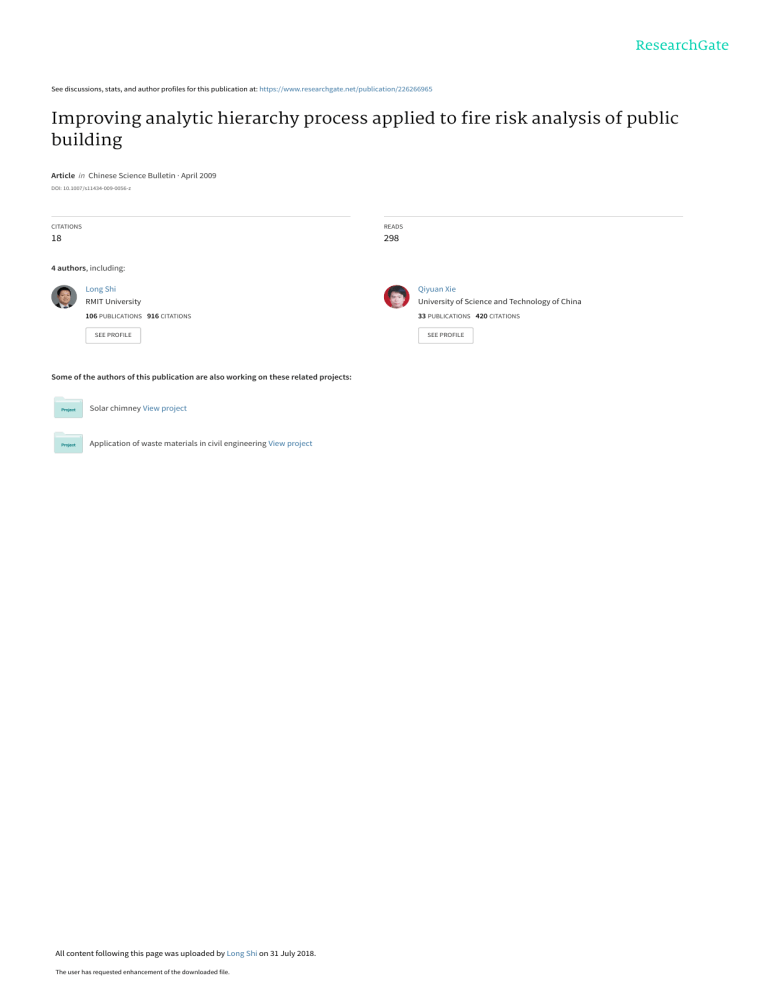
See discussions, stats, and author profiles for this publication at: https://www.researchgate.net/publication/226266965 Improving analytic hierarchy process applied to fire risk analysis of public building Article in Chinese Science Bulletin · April 2009 DOI: 10.1007/s11434-009-0056-z CITATIONS READS 18 298 4 authors, including: Long Shi Qiyuan Xie RMIT University University of Science and Technology of China 106 PUBLICATIONS 916 CITATIONS 33 PUBLICATIONS 420 CITATIONS SEE PROFILE Some of the authors of this publication are also working on these related projects: Solar chimney View project Application of waste materials in civil engineering View project All content following this page was uploaded by Long Shi on 31 July 2018. The user has requested enhancement of the downloaded file. SEE PROFILE ARTICLES Shi L, Zhang RF, Xie QY, & Fu LH. (2009). Improving analytic hierarchy process applied to fire risk analysis of public building. Chinese Science Bulletin, 54, 1442-1450 Chinese Science Bulletin © 2008 SCIENCE IN CHINA PRESS Springer Improving analytic hierarchy process applied to fire risk analysis of public building SHI Long*, ZHANG RuiFang, XIE QiYuan & FU LiHua State Key Laboratory of Fire Science, University of Science and Technology of China, Hefei 230027, China The structure importance in Fault Tree Analysis (FTA) reflects how important Basic Events are to Top Event. Attribute at alternative level in Analytic Hierarchy Process (AHP) also reflect its importance to general goal. Based on the coherence of these two methods, an improved AHP is put forward. Using this improved method, how important the attribute is to the fire safety of public building can be analyzed more credibly because of the reduction of subjective judgment. Olympic venues are very important public buildings in China. The fire safety evaluation of them will be a big issue to engineers. Improved AHP is a useful tool to the safety evaluation to these Olympic venues, and it will guide the evaluation in other areas. With the booming development of economy in China, And it has significant meanings to fire risk analysis in office buildings of different grades have become popular public buildings and also other correlative areas. in daily life. Higher requirements of fire safety in public The Olympic venues are significant buildings in public buildings are claimed. Methods of how to evaluate more buildings. Every four years’ Olympic games collected so credibly have become more important. Currently, a lot much attention to it. Lots of fire cases warned safety of evaluation methods have been applied to fire safety in managers of the fire safety in Olympic venues[9, 10]. On public building, such as Gustav Purt’s fire risk May 11, 1985 the main stand of Bradford City Football [1] evaluation method , Fuzzy comprehensive judge Club caught fire. Fifty six people were burnt to death method[2], Event tree analysis[3, 4], Fault tree analysis[5, 6], and about 250 injured. As the date of Beijing Olympics [7, 8] Analytic Hierarchy Process . neared, more and more engineers concentrated their Because of the limit of occurrence probability of basic attentions to fire safety of the Olympic venues, such as events in FTA, the quantitative analysis was rarely used. the National Stadium, National Aquatics Center, Peking In AHP, the analysis results were greatly dependent on University Gymnasium, etc. High personnel load, large judgment matrix, which was always influenced by our *Corresponding author (email:[email protected]) subjective judgment. In this paper, a combination of qualitative analysis in FTA with quantitative analysis in AHP is taken in order to reduce subjective judgment. Support by the National Science Foundation of China (Grant No.50536030), the National Project of Scientific and Technical Supporting Programs funded by the Ministry of Science & Technology of China (Grant NO.2006BAK06B02) and the China Postdoctoral Science Foundation (Grant No.20070410220). MEDICAL GENETICS public building, fire risk analysis, AHP, FTA, Olympic venues spaces, complicated structures are the three important tree should add an apostrophe which denotes the characters of these Olympic venues. How to evaluate opposite event in fault tree. fire risk of the Olympic venues more credibly is Fault tree is made up of many basic events with meaningful to engineers. different importance to the top event. The importance grade of basic events to top event can be gained when 1 1.1 Basic principles the occurrence probability of each basic event is the Fault tree analysis same. This kind of importance is called structure Fault tree diagrams represent the logical relationship importance[14], and is given by: between sub-system and component failures and how Iϕ (i) = they combine to cause system failures. It follows the logic analysis principle which deduces the reasons of fault events from results, and these factors are connected by logic gates. The way using fault tree to analyze the failures is called fault tree analysis[11-14]. If all basic events happened, it will lead to top event appearance. The combination of several basic events 1 m 1 ∑ k j =1 R j (1) where k is the number of minimal cut or path sets in fault tree; m is the number of minimal cut or path sets containing the basic event i; Rj is the number of basic event minimal cut j or path set j which contains basic event i. will also have the same effect and is called minimal cut 1.2 Analytic hierarchy process set, meaning all the unique combination of component Analytic Hierarchy Process is a system analysis method failures that would cause system failure. Every single developed by T. L. Saaty[16, 17] in 1970s. AHP model cut set means a way to result top event appearance. divides the complex system into three levels, namely the Consequently, the larger number of cut sets represents objective level (top level), the criteria level (middle the higher possibility of top event appearance. On the level) and the alternative level (bottom level). By contrary, a union of opposite basic events will stop the organizing and assessing alternatives against a hierarchy top event appearance and is named minimal path set, of multifaceted objectives, AHP provides a proven, meaning all the unique union of components assuring effective means to deal with complex decision making. system safety. Each minimal path set means that there is Furthermore, AHP allows a better, easier, and more a method to stop top event appearance, therefore, the efficient identification of selection criteria, as well as larger number of minimal path sets means safer systems. their weighting and analysis. Many methods can be used to obtain minimal cut sets, Generally, the objective level contains only one top goal Boolean Algebra Arithmetic and Fussell-Vesely methods and there are several factors at the middle level, and are two of them[15]. Because of the duality of minimal each factor is made up of some attributes at the cut set and minimal path set, the usual way to gain alternative level. Based on the connection of each factor minimal path sets should first change fault tree to and attribute, AHP model will be built from the top to success tree by replacing the gates in an opposite way, bottom just like tree structure. The attributes contained for example replacing the AND gates to OR gates and in the same factor at the objective level have effect to it, OR gates to AND gates. So the minimal cut sets in in the mean time, and each factor also affects the top success tree are the minimal path cuts in the original goal. fault tree. To make it clear, each basic event in success To gain a judgment matrix, attributes belonging to the ARTICLES same factor at the criteria level are compared pair-wise in a quantitative way to express the relative preference. After constructing the judgment matrix, weights of To construct the judgment matrix, there are a lot of factors can be shown in the eigenvector of the matrix, [18] scales and 1~9 scales are the commonly used. The comparison scales of judgment and their meanings are which is related to the largest eigenvalue. Details are presented in Ref. [19] and [20]. shown in Table 1. [19] Table 1 The comparison scales of judgment and their meanings Scale Verbal judgment of preferences 1 Equally preferred 3 Moderately preferred 5 Strongly preferred 7 Very strongly preferred 9 Extremely preferred 2,4,6,8 Mean-value of two near situations above 2 Build AHP model by fault tree 2.1 Fault tree The casualty in public building fire is mainly due to two reasons, one is the control failure of fire and the other is the evacuation failure. The fault tree with the top event in public building fire resulting in casualty is shown in Fig. 1. Reasons for casualty in public building begin with two management, fire protection facilities, building structure middle events, i.e. fire spreading and evacuation failures, and fire protection factors. The top goal is fire safety of and twenty basic events are deduced according to these public building. The AHP model constructed by fault two middle events. The symbols and their meanings in tree is shown in Table 3. this fault tree are shown in Table 2. 2.3 Judgment matrix 2.2 AHP model attributes in AHP model by modifying the description to In AHP model, judgment matrix (A or aij) can be constructed by pair-wise comparisons between factors at the same level. The judgment matrix is the analysis basic of AHP and the weight of factors to top goal can be obtained from it. a neutral one. Then these attributes are classified into As the value of structure importance is fraction, it is too different factors at the criteria level, such as safety vague to express relative preference in pair-wise Because of the different description between FTP and AHP, basic events in fault tree should be changed to MEDICAL GENETICS Figure 1 The fault tree of public building fire resulting in casualty comparison. So the judgment factor is come out in importance in formula 1. formula 2. LCM is least common multiple of each χ (i) = Iϕ (i) i LCM denominator value, which comes from structure (2) Table 2 Symbols and their meanings in fault tree Symbols and meanings Symbols and meanings Symbols and meanings B1 Fire spread E2 Unsuccessful fire-fighting of fire bridge X8 Poor fire resistance rating B2 Evacuation failure E3 Poor fire-fighting capacity of building itself X9 Smoke control system failure C1 Fire happen E4 No in time fire suppression X10 Reasonless fire compartment C2 Control fire failure E5 Lack self-rescue capacity X11 Lack fire-fighting capacity of fire bridge C3 Self-rescue and rescue failure F1 Inadvertent usage of open fire X12 Long distant of fire station C4 Cannot escape F2 Electrical failure fire X13 Fire hydrant system failure D1 Exist hazards X1 Lack daily safety inspection X14 Sprinkler system failure D2 Lack management X2 Poor occupants’ fire-prevention X15 Fire alarm system failure quality D3 Poor fire-resistant ability of building X3 Lack safety facilities of distribution X16 Lack fire-fighting equipment equipment D4 Poor fire-fighting capacity X4 Poor fire-resistant of electrical equipment X17 Lack emergency plan and drill D5 Rescue failure of fire bridge X5 Lack safety knowledge propaganda X18 High personnel load D6 Self-rescue failure X6 Poor management level X19 Strait evacuation exits D7 Poor evacuation capacity X7 Fuel load in building X20 No evacuation indicators or unclear E1 Fire sources Table 3 Objective Criteria level level Analytic hierarchy process model Alternative level Daily fire safety inspection(X1) Safety knowledge propaganda(X5) Safety Safety facilities of distribution equipment(X3) Management level(X6) management Fire-resistant of electrical equipment(X4) Emergency plan and drill(X17) (B1) Fire safety Fire protection Smoke control system(X9) Fire alarm system(X15) of facilities(B2) Fire hydrant system(X13) Fire-fighting equipments(X16) public building Sprinkler system(X14) Building Fuel load in building(X7) Evacuation exits(X19) structure Fire resistance rating(X8) Evacuation indicators(X20) (B3) Fire compartment(X10) Fire Occupants’ fire-prevention quality(X2) Distant of fire station(X12) protection Fire-fighting capacity of fire bridge(X11) Personnel load(X18) factors(B4) Judgment factor reflects the importance of basic events by pair-wise comparison. As each factor at the criteria to top goal and can be used to construct judgment matrix level contains several attributes at the alternative level, W= m summing them up and is denoted as ∑ χ (i) . Generally, αW ′ + βW ′′ α +β (5) ARTICLES the judgment factor of each factor can be calculated by i =1 a ij in the judgment matrix always expressed as an where α, β are the weight coefficients, which are the integer and can be rounded as an integer, and is summation of scale factor (φ) and consistency ratio expressed by: factor (ε). ⎧ ⎪ ⎪ a ij ⎪ ⎪⎪ ⎨ ⎪ ⎪ ⎪a ji ⎪ ⎪⎩ Scale factor reflects the errors when different numerical m ∑ χ (i) i =1 n , ∑ χ ( j) m n i =1 j =1 scales are chosen. Similarly, the consistency ratio factor ∑ χ (i) ≥ ∑ χ ( j) j =1 (3) matrix. So the weight coefficient can be gained by n ∑ χ ( j) j =1 m ∑ χ (i) also relate to the errors in the calculation of judgment , m n i =1 j =1 combining these two factors together. Details will be ∑ χ (i) < ∑ χ ( j) expatiated in sections below. i =1 3.2 The weight coefficient where m, n denote the number of attributes belonging to each factor at the criteria level; i, j are row and line 3.2.1 Numerical scale for judgment matrix number in the judgment matrix respectively. T. L. Saaty compared 1~9 scales with other 26 kinds of Each factor at the criteria level contains several numerical scales[20]. In the experiment, four chairs were alternative placed in line and had the distances of 8.230, 13.716, level, the judgment matrix by pair-wise comparisons is 19.202, 25.603 meters from the light source respectively. denoted as: The judger stood by the light source and judged the ⎧ ⎪a ij ⎪ ⎨ ⎪a ⎪⎩ ji χ (i) , χ ( j) χ ( j) , χ (i) relative brightness of each chair. In this way, the χ (i) ≥ χ ( j) judgment matrix was constructed. By calculating the (4) χ (i) < χ ( j) where i, j are row and line number in the judgment matrix respectively. 3 The improved AHP 3.1 The combined weight Utilizing the judgment matrix constructed by structure eigenvector related to the largest eigenvalue, relative brightness (ai ) of each chair can be gained. In the mean time, actual relative brightness (bi) can be obtained by the Light Intensity Law. Details are represented in Ref. [20]. These two data arrays a1, a2, …, an and b1, b2, …, bn are compared by Root Mean Square (RMS)[20], which is expressed by: RMS = importance in FTA, the weight of each factor can be 1 n (ai − bi ) 2 ∑ n i =1 (6) gained and is denoted as W′. The weight of each factor RMS values reflect the credibility of judgment matrix can also be gained through experts’ judgment and is and can be used to gain the scale factor (φ), and can be expressed as W〞 in AHP. As the structure importance expressed by: and the weight have the same effect on top event or goal, these two can be combined with each other to make the judgment more credible, and the combined weight can be expressed by: ϕ = 1− RMS − Rmin Rmax − Rmin (7) where RMS is the root mean square of these two data arrays; Rmax is the maximal value of RMS, which MEDICAL GENETICS attributes at the alternative level. At the happens when 1~90 scales are chosen; Rmin is the Different chosen numerical scales result in different minimal value of RMS, which happens when 1~9 scales RMS values. Scale factors can be obtained by formula 7, are chosen. and are listed in Table 4. Table 4 Scale factors with different numerical scales Scales 3 5 7 9 11 13 15 17 18 26 φ 0.4610 0.7597 0.9286 1.000 0.8506 0.7468 0.6948 0.6234 0.5844 0.4091 Scales 30 34 36 44 52 60 68 75 85 90 φ 0.3831 0.3182 0.2922 0.2078 0.1688 0.1429 0.0909 0.0779 0.0325 0 Scale factors of the missing scales in the middle can be gained by interpolation method. value is zero. 3.2.2 Consistency check of judgment matrix When the pair-wise comparisons are taken to construct judgment matrix, whose order is larger than two, there will be judgment errors as calculation process develops. CR[19] mentioned in formula 9 is denoted as consistency ratio of an AHP model in total hierarchy permutation and goes as follow: m Therefore, the consistency check is useful when the order of judgment matrix is larger than two. Consistency CR = Index (CI)[19] is used for consistency check and goes as ∑ a CI j j=1 m ∑ a RI j j=1 follow: CI = λmax − n (8) n −1 j (10) j where aj is the weight of each factor at the criteria level; CIj is the CI value of attributes at the criteria level; RIj is Consistency Ratio (CR) also reflects incredibility of a the Random consistency index and shown in Table 5. judgment matrix, and CR factor is expressed as: ε = 1− CR − CR m in = 1 − 10CR CR m ax − CR m in (9) where CRmax is the maximal value of CR and the value is 0.1; CRmin denotes the minimal value of CR and the Table 5 [21] The value of Random consistency Index (RI) Size of matrix 1 2 3 4 5 6 7 8 9 10 RI 0 0 0.58 0.9 1.12 1.24 1.32 1.41 1.45 1.49 minimal cut sets in this fault tree. In an easier way, the 4 Application example structure importance can be obtained by calculating the 4.1 Construction of judgment matrix minimal path sets, which is gained by changing the fault 4.1.2 Construction by fault tree It is difficult to gain structure importance by calculating the minimal cut sets because of the huge number of tree to a success tree. There are twelve minimal path sets in this fault tree: ARTICLES P1 = { X 1' ,X 3' } P2 = { X 1' ,X 4' } P3 = { X 2' ,X 3' } P4 = { X 2' ,X 4' } P5 = { X 7' } P6 = { X 1' ,X 5' ,X 6' } P7 = { X 8' ,X 9' ,X 10' } P8 = { X 11' ,X 12' } P9 = { X 13' } P10 = { X 14' } P11 = { X 2' 、X 5' 、X 16' } P12 = { X 5' ,X 15' ,X 17' ,X 18' ,X 19' ,X 20' } Table 6 Structure importance and judgment factors of each basic event Basic events Structure importance Judgment factor χ(i) Basic events Structure importance Judgment factor χ(i) X 1' X 2' X 3' X 4' X 5' X 6' X 7' X 8' X 9' X 10' 1 9 1 9 1 12 1 12 1 24 1 36 1 12 1 36 1 36 1 36 8 8 6 6 3 2 6 2 2 2 X 11' X 12' X 13' X 14' X 15' X 16' X 17' X 18' X 19' X 20' 1 24 1 24 1 12 1 12 1 24 1 36 1 72 1 72 1 72 1 72 3 3 6 6 3 2 1 1 1 1 Through formula 1, the structure importance of each basic event is listed in Table 6. the judgment factors of each attribute, which belongs to safety management. In this way, the judgment factor Based on the structure importance of each basic event, value of safety management, fire protection facilities, the least common multiple of each denominator can be building structure and fire protection factors are 26, 19, obtained and the value is 72. Through formula 2, 12 and 15, respectively. Using formula 3, a14 in the judgment factor can be gained and details are listed in judgment Table 6. As shown in Table 3, safety management at the criteria level contains six attributes, i.e. X ' 5 ' 6 ' 17 ' 1, ' 3 ' 4 X , X , matrix m m i =1 i =1 is calculated a14 = ∑ χ (1) / ∑ χ (4) = 1.7 in this way: 2 . The judgment matrix at the criteria level is shown in Table 7. X , X , X . So the judgment factor of safety ∑ χ (1) =1 iTable 7 is the summation of Judgment matrix of each factor at the objective level constructed by fault tree B1 B2 B3 B4 Weight Safety management(B1) 1 1 2 2 0.3381 Fire protection facilities(B2) 1 1 2 1 0.2881 Building structure(B3) 1/2 1/2 1 1 0.1690 Fire protection factors(B4) 1/2 1 1 1 0.2048 The local weight of attributes can be gained in the same way as factors at the criteria level goes. By total hierarchy permutation in AHP model, the global weights of each attribute can be obtained and are shown in Table 9. 4.1.2 Construction by traditional AHP In traditional AHP, the judgment matrix is obtained by MEDICAL GENETICS m management denoted as choosing numerical scale and the usual choice is 1~9 structure and fire protection factors, by experts’ scales shown in Table 1. The pair-wise comparisons are judgment and the judgment matrix gained is shown in taken among four factors at the criteria level, namely Table 8. safety management, fire protection facilities, building Table 8 Judgment matrix of each factor at the criteria level constructed by traditional AHP B1 B2 B3 B4 Weight Safety management(B1) 1 1 2 3 0.3562 Fire protection facilities(B2) 1 1 2 2 0.3250 Building structure(B3) 1/2 1/2 1 2 0.1937 Fire protection factors(B4) 1/3 1/2 1/2 1 0.1251 In the same way, the judgment matrix can also be and W″, which are gained from the AHP model carried out at the alternative level between the attributes constructed by fault tree and traditional AHP model belonged to the same factor, and the local weights of respectively. And the combined weight of each attribute each attributes can be obtained. The global weights of is listed in Table 9. The rank-order of each attribute is each attribute can be gained through total hierarchy gained by accumulative sequence. permutation in AHP model and are shown in Table 9. As shown in Table 9, the rank-ordering of three 4.2 Weight coefficient α and β attributes ascended greatly in the improved AHP, such Based on the AHP model constructed by fault tree, the maximal value of numerical scale value as known above is 26, which is the judgment factor of safety management at the criteria level. Table 4 show the scale factor (φ) is 0.4091 when the judgment factor is 26. Through formula 9 and 10, CR factor can be gained and the value is 0.9590. So weight coefficient of AHP model constructed by fault tree goes as follow: α= scale factor (φ) +CR factor (ε) =1.3681 Similarly, in traditional AHP model, the maximal value of numerical scale is 9, which is usually used by decision-maker. As shown in Table 4, the scale factor (φ) is 1.0. The calculation of CR factors is just like the way above and the value is 0.5650, so the weight coefficient of traditional AHP model is: β = scale factor (φ) +CR factor (ε) =1.5650 4.3 Results and analysis as Occupants’ fire-prevention quality (X2), Safety facilities of distribution equipments (X3) and Fire-resistant of electrical equipment (X4). It is found that the rank-ordering of Occupants’ fire-prevention quality (X2) rose from 20 to 7 in the improved AHP. A fire statistics showed that 42987 fires happened in 2004 in China because of people’s fault (about 30.2 percent) and electrical problems (about 20.7 percent)[22]. People’s fault was one type of activities in occupants’ fire-prevention quality and was the main reason causing the fire. In traditional AHP, the rank-ordering of X2 is 20 and there exists the underestimation of occupants’ fire-prevention. So the result of improved AHP avoids this kind of underestimation and reduces misjudgment. The rank-ordering of Safety facilities of distribution equipments (X3) and Fire-resistant of electrical equipments (X4) rise by 6 in the improved AHP. Electrical problem is the second important reason Using formula 5, the combined weight of each attribute causing fire, and the rank-ordering in the improved AHP in the improved AHP model can be carried out by W′ answer for this statistics data correctly. Attribute Attribute name ARTICLES Table 9 The combined weight of each attribute W′ level Rank- W〞 ordering Rank- W ordering Rankordering X1 Daily safety inspection 0.0965 2 0.1237 1 0.1110 1 X3 Safety facilities of distribution 0.0817 6 0.0218 15 0.0497 9 X4 Fire-resistant of electrical equipment 0.0817 6 0.0270 14 0.0525 8 X5 Safety knowledge propaganda 0.0404 9 0.0871 3 0.0653 5 X6 Management level 0.0249 16 0.0422 10 0.0341 15 X17 Emergency plan and drill 0.0130 20 0.0544 8 0.0351 14 X9 Smoke control system 0.0285 12 0.0216 16 0.0248 17 X13 Fire hydrant system 0.0902 3 0.0371 11 0.0619 6 X14 Sprinkler system 0.0902 3 0.1152 2 0.1035 2 X15 Fire alarm system 0.0508 8 0.0873 4 0.0703 4 X16 Fire-fighting equipment 0.0285 12 0.0639 6 0.0474 10 X7 Fuel load in building 0.0845 5 0.0753 5 0.0796 3 X8 Fire resistance rating 0.0282 14 0.0131 19 0.0201 19 X10 Fire compartment 0.0282 14 0.0521 9 0.0410 11 X19 Evacuation exits 0.0141 17 0.0322 13 0.0238 18 X20 Evacuation indicators 0.0141 17 0.0210 17 0.0178 20 X2 Occupants’ fire-prevention quality 0.1135 1 0.0120 20 0.0593 7 X11 Fire-fight capacity of fire bridge 0.0390 10 0.0202 18 0.0290 16 X12 Distant of fire station 0.0390 10 0.0347 12 0.0367 13 X18 Personnel load 0.0134 19 0.0583 7 0.0374 12 There are also some attributes descending their so important to personal safety when the evacuation rank-ordering in the improved AHP. Take evacuation keeps in good order. No casualty happened in the fire in exits (X19) for example, the rank-ordering descended Sendai supermarket in Japan and 2000 persons from 13 to 18. That is to say, evacuation exit is less evacuated safely because of great evacuation order[23]. important to the personal safety comparing with some This case has a favorable illustration to the improved other attributes in public building. 74 persons died in the AHP. fire of Illinois State Hospital in 1948. Although there Besides, several attributes have the same rank-ordering were plenty of evacuation exits, so many people died of weight, such as daily safety inspection (X1), Fire when fire spread rapidly because flammable materials resistance rating (X8), Sprinkler system (X14), Fire [23] were used in this hospital largely . From this case, it is alarm system (X15). Sprinkler system had great known that Fuel load in building (X7) is more important influence on fire safety of buildings. A fire statistics in to evacuation exits (X19). The rank-ordering of X7 and USA showed that residential sprinklers decreased the X19 in the improved AHP was proved by this case home fire death rate per 100 fires by 74%[24]. Also fire exactly. Personnel load (X18) has effect on personal alarm system had great significance to fire safety. On safety in public building. So many people died because November 29, 1995, the electrical cables in Shanghai of high personnel load. However, personnel load is not Stadium released smoke because of overload. The given MEDICAL GENETICS equipment cues by fire alarm system avoided a big fire. and fire alarm system (X15) have important influence Differences exist in these two evaluation method. on fire safety of public buildings and safety managers Because of the without thinking of the occurrence should pay attention to these attributes. probability of basic events in FTA and existent of subjective judgment in the construction of judgment 5 Safety assessment of Olympic venues matrix, in some extent, there will exist error in the result. 5.1 Fuzzy AHP Therefore, the analysis result of the improved AHP in The fuzzy AHP[25, 26] is used in this paper to evaluate the this paper, which is the combination of these two Olympic venues. Safety levels in Olympic venues are evaluation methods, will show more creditability in listed in Table 10. Based on these safety levels, the mark evaluation. in evaluation vector of Olympic venues for excellence, Known from Table 9, attributes such as daily safety good, medium, bad, very bad are 95, 85, 75, 65, 55 inspection (X1), sprinkler system (X14), fire load (X7) respectively. Table 10 Safety levels in Olympic venues Mark ≥ 90 90~80 80~70 70~60 <60 Safety level Excellence Good Medium Bad Very bad Combining the weight from the improved AHP and the w = [0.3477 0.3079 0.1823 0.1624] judgment to Olympic venues, an evaluation mark will At the alternative level, the weight of attributes can be be gained. The mark will be a good reflection of fire calculated by normalization. The weights of attributes at safety in Olympic venues. From Table 9, the weight of the attribute level to top goal are gained by the improved factors at the criteria level can be gained: AHP: wB1 = [0.3192 0.1429 0.1510 0.1878 0.0981 0.1009] wB 2 = [0.0805 0.2010 0.3361 0.2283 0.1539] wB3 = [0.4366 0.1103 0.2249 0.1306 0.0976] wB 4 = [0.3651 0.1786 0.2260 0.2303] 5.2 Assessment and results according to investigations. The safety level of each The assessment of Olympic venue was really a huge attributes at the alternatively level had to be confirmed project and evaluation by a single person might bring by every expert. Take one Olympic venue for example, prejudgment. Five experts formed the expert assessment with the collection of judgment from every expert, the group. Attributes at the alternatively level were judged judgment matrixes are came out: ⎡ 0.8 ⎢0.6 ⎢ ⎢0.4 R1 = ⎢ ⎢0.2 ⎢ 0.8 ⎢ ⎣0.6 0.2 ⎡0.8 ⎢0.4 ⎢ R3 = ⎢0.6 ⎢ ⎢0.4 ⎢⎣0.4 0.2 0 0.6 0 0.2 0.2 0.2 0.4 0.4 0.2 0 0.4 0 0.4 0.2 0.4 0.2 0.2 0 0.2 0.2 0 0⎤ 0 0⎥⎥ 0 0⎥ ⎥ 0 0⎥ 0 0⎥ ⎥ 0 0⎦ 0 0⎤ 0 0 ⎥⎥ 0 0⎥ ⎥ 0 0⎥ 0 0 ⎥⎦ ⎡0.4 ⎢0.4 ⎢ R2 = ⎢0.2 ⎢ ⎢0.4 ⎢⎣0.6 ⎡0.2 ⎢0.6 R4 = ⎢ ⎢ 0.8 ⎢ ⎣0.4 0⎤ 0.2 0 0 ⎥⎥ 0.2 0 0 ⎥ ⎥ 0.2 0.2 0 ⎥ 0.2 0 0 ⎥⎦ 0.4 0.2 0.4 0.6 0.2 0.2 0 0.6 0.2 0 0 ⎤ 0.2 0.2 0 0 ⎥⎥ 0.2 0 0 0 ⎥ ⎥ 0.4 0.2 0 0 ⎦ [27]. Using the weight obtained from the improved AHP F=[95 85 75 65 55 ]·[0.4995 0.3351 0.1386 0.0141 0]T ARTICLES Details about the fuzzy AHP were represented in Ref. =87.25 and the judgment matrixes, the final mark of Olympic From Table 10, it is know that the safety level of this venue could be calculated: Olympic venue is good. has great significances to the establishment of 6 Conclusion FTA and AHP were widely used in risk evaluation in various areas. Based on the coherence and merits of FTA and AHP, combining structure importance of each basic event in fault tree with the weight in traditional AHP, the combined weights of attributes have been carried out. The improved AHP reduces the judgment error and makes the analysis more creditable when the fire-protection measures. The daily safety inspection, sprinkler system, fire load and fire alarm system have paramount influence on fire safety of public buildings, and safety managers must pay attention to these attributes. Moreover, the weight of each attribute in public building can be applied by the fuzzy AHP to the evaluation of fire risk of Olympic venues. Also the improved AHP will guide the evaluation in other areas. qualitative analysis in FTA and quantitative analysis in AHP are combined. The improved AHP helps to analyze how important is each attribute to fire safety of public buildings. And it 2 Fu Q, Zhang H P, Wang H. Study on public building fire risk Installation. Chengdu: Sichuan Publishing House of Science and assessment method. Fire Safe Sci, 2007, 16(3): 137-142 Technology, 1996: 10-25 Du H B, Zhou X Q, Zhang J Z. Fuzzy synthetic evaluation for fire 14 Wu A Y, Wang C L, Xiao G Q. Application of Fault Tree Analysis 15 Gu L, Liu X D, Yan H Q. Application of Fault Tree to Risk safety of high-rise buildings. J China Univ Min Technol, 2002, 31(3): 242-245 3 in casualty of building fire. China Safe Sci J, 2005, 15(5): 92-95 Chu G Q, Chen T, Sun Z H, et.al. Probabilistic risk assessment for Assessment of fire and explosion at oil-fuel depot. Envrion Sci evacuees in building fires. Build Environ, 2007(42): 1283-1290 4 Li H M. Analysis of university dormitory electrical fire based on Technol, 2007, 30(6): 52-54 16 judgments in the Analytic Hierarchy Processs. Math Comput Model. Event Tree Approach. Sci Technol West China, 2008(1): 62-63 5 6 17 18 Hikmat H A, Saba F A N. Developing a green building assessment Res, 2008(186): 229-242 19 9 20 21 Shi J Y, Ren A Z. Application of computer simulation technology to 22 2005, 24(3): 263-266 Disasters, 2005(4): 95-102 Vaurio J K. Common cause failure probabilities in standby safety 23 Fire Technol Prod Inform, 2002(8): 59-67 dependencies. Reliab Eng Syst Safe, 2003, (79): 43-57 13 Reay K A, Andrews J D. A fault tree analysis strategy using binary Guo R H. The history of fire investigation in America, U.K. and Japan —efforts of fire investigation to evacuation plan in building. system Fault Tree Analysis with testing—scheme and timing 12 Guo T N. Fire status in 2004 and the fire development tendency as well as counter measures now and in the future. Fire Sci Technol, fire safety analysis of gymnasiums for 2008 Olympic Games. J Nat 11 Kariuki S G, Löwe K. Integrating human factors into process hazard analysis. Reliab Eng Syst Safe, 2007(92): 1764-1773 venues. Safety Sci, 2008(46): 302—322 10 ZhaoH C, Xu S B, He J S, Analytic Hierarchy Process —One New Method for Decision-making. Beijing: Science Press, 1986: 9-24 Johnson C W. Using evacuation simulations for contingency planning to enhance the security and safety of the 2012 Olympic Liu T M, Zhang X K, Liu G Z. A Guide of Safety Evaluation Application. Beijing: Chemical Industry Press, 2005: 15-38 tool for developing countries – case of Jordan. Build Environ (2008), dio:10.1016/j.buildenv. 2008.07.015: 1-12 Dong Y C, Xu Y F, Li H Y, et.al. A comparative study of the numerical scales and the prioritization methods in AHP. Eur J Oper Zheng S Z, Gao Y T, Chen B Z. The index system study of building fire hazard evaluation in the city. Fire Sci Technol, 2001, (5): 12-13 8 Saaty T L, Shang J S. Group decision-making: Head-count versus intensity of preference. Socio Econ Plan Sci, 2007(41): 22-37 Zhang G J, Dai X J, Li W. Fault Tree Analysis of fire accident of large-scale hotel. Safe Environ Eng, 2007(4): 83-85 7 2007(46): 962-975 Liu A H, Shi S L, Wu C. The index system design of the high building fire hazard assessment. Eng Sci, 2006, 8(9): 90-94 Saaty T L, Tran L T. On the invalidity of fuzzifying numerical 24 Rohr K D, Hall J R. U.S. Experience with Sprinklers and other Fire decision diagrams. Reliab Eng Syst Safe, 2002(78): 45-56 Extinguishing Equipment. Technology Report, Fire Analysis and Chen B Z. Identification, Evaluation and Control of Hazard Research Division, National Fire Protection Association. 2005: 1- MEDICAL GENETICS 1 5 25 Fuzzy AHP and its applications. Eur J Oper Res, 2008(186): 735- 26 occupancy public buildings. Master Dissertation. Chongqing: Wang Y M, Luo Y, Hua Z S. On the extent analysis method for Chongqing University, 2006: 23-64 27 Yu Z P, Lu Y S. Application of fuzzy analytical hierarchy process in 747 enterprise safety assessment. J Safe Sci Technol, 2006, 2(3): 119- Lin L. The exploration on safety grade assessment of high 121 View publication stats
